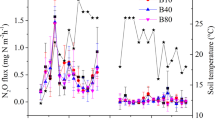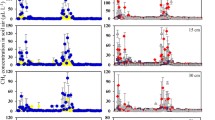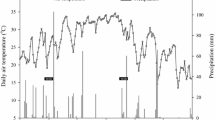Abstract
Application of a commercial formulation of the herbicide butachlor (N-butoxymethyl-2-chloro-2′,6′-diethyl acetanilide) at 1 kg a.i. ha–1 to an alluvial soil planted with direct-seeded flooded rice (cv. Annada), significantly inhibited both crop-mediated emission and ebullition fluxes of methane (CH4). Over a cropping period of 110 days, the crop-mediated cumulative emission flux of CH4 was lowered by ∼20% in butachlor-treated field plots compared with that of an untreated control. Concurrently, ebollition flux of CH4 was also retarded in butachlor-treated field plots by about 81% compared with that of control plots. Significant relationships existed between CH4 emission and redox potential (E h) and Fe2+ content of the flooded soil. Application of butachlor retarded a drop in soil redox potential as well as accumulation of Fe2+ in treated field plots. Methanogenic bacterial population, counted at the maturity stage of the crop, was also low in butachlor-treated plots, indicating both direct and indirect inhibitory effects of butachlor on methanogenic bacterial populations and their activity. Results indicate that butachlor, even at field-application level, can effectively abate CH4 emission and ebollition from flooded soils planted to rice whilst maintaining grain yield.
Similar content being viewed by others
Explore related subjects
Discover the latest articles and news from researchers in related subjects, suggested using machine learning.Author information
Authors and Affiliations
Additional information
Received: 15 March 2000
Rights and permissions
About this article
Cite this article
Mohanty, S., Bharati, K., Moorthy, B. et al. Effect of the herbicide butachlor on methane emission and ebullition flux from a direct-seeded flooded rice field. Biol Fertil Soils 33, 175–180 (2001). https://doi.org/10.1007/s003740000301
Issue Date:
DOI: https://doi.org/10.1007/s003740000301




